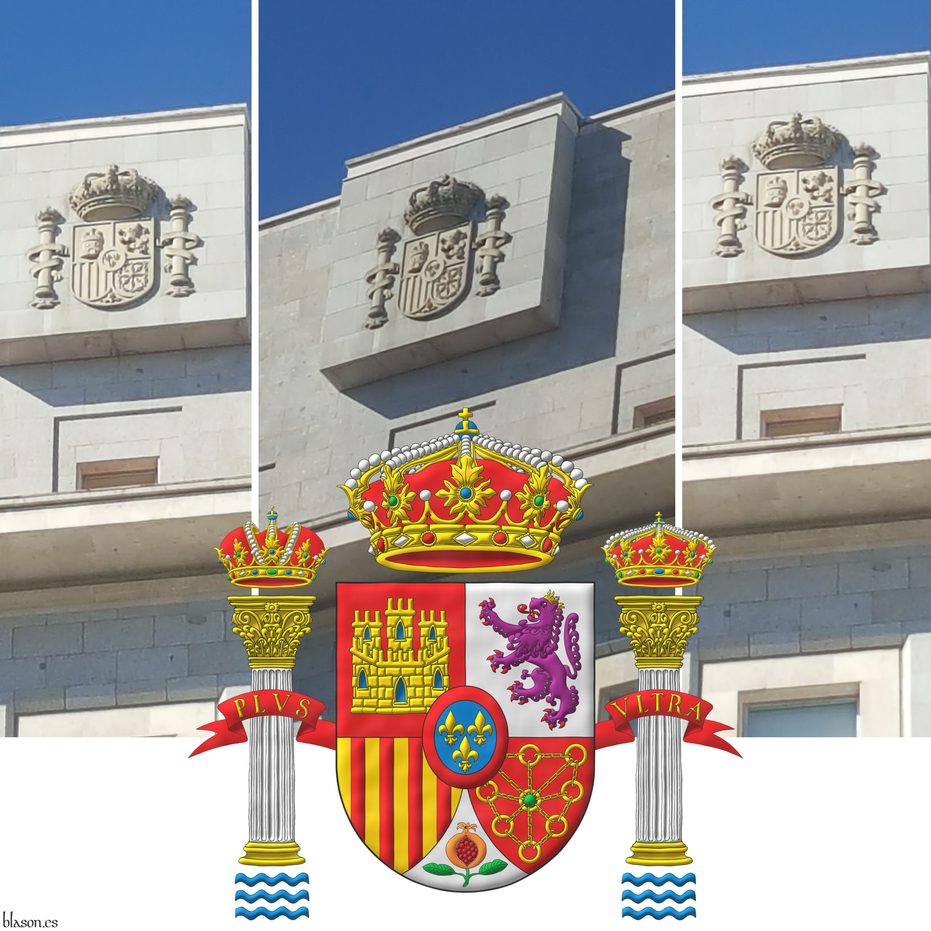Supporter (thing)


Supporters: Behind the shield, two scimitars in saltire Or.
Sostenido por dos cimitarras en sotuer de oro, acoladas detrás del escudo.
Two scimitars illuminated in metal Or, and outlined in Sable.
supporter (thing), supporters (things): supporter.
Exterior ornament of the coat of arms, being a plant or a object that supports it. There may be only one, placed on one side or behind the coat of arms, although it is usual to represent two: one on the dexter and another on the sinister side, or behind the shield in saltire. which may be symmetrical, for example, two columns, or different, for example, a sword and a sabre.
In Spain, objects supporting coats of arms are not uncommon, beginning with the two columns of the national arms. In the army and navy, there are cannons, swords, rifles, and anchors. There are also other unusual examples, such as the coat of arms of the city of Valencia, which has two crowned capital letters L as supporters. By contrast, objects and plants are practically non-existent in the heraldry of the British Isles.
Categories: Supporter (thing), Supporter and Glossary.


A liden behind the arms of the Strategy Department of Consultoria.IO
Azure, on waves of the sea in base Argent, a ship oars in action Or, pennant flying, and in full sail Argent; on a chief Argent, a closed book Gules, edges and clasps Or. Supporter behind the shield: A linden eradicated Sable, leaved Vert, fructed Or.
Coat of arms devised by me, illuminated with lights and shadows, with a pointed external shape and with a freehand finishing.
Blazon keywords: Azure, Argent, Or, Gules, Sable, Vert, One, Wavy, Sea, In base, On, Ship, Oar, Sail, Chief, Closed book, Book, Clasped, Supporter (thing), Supporter, Behind the shield, Linden, Eradicated, Leaved, Fructed, Motto and Scroll.
Style keywords: Illuminated, Pointed and Freehand.
Classification: Socioeconomic, Created, Boa, Coat of arms, Pennon and Flag.
Bearer: Strategy Department of Consultoria.IO.


A liden supporting the arms of the Strategy Department of Consultoria.IO with motto
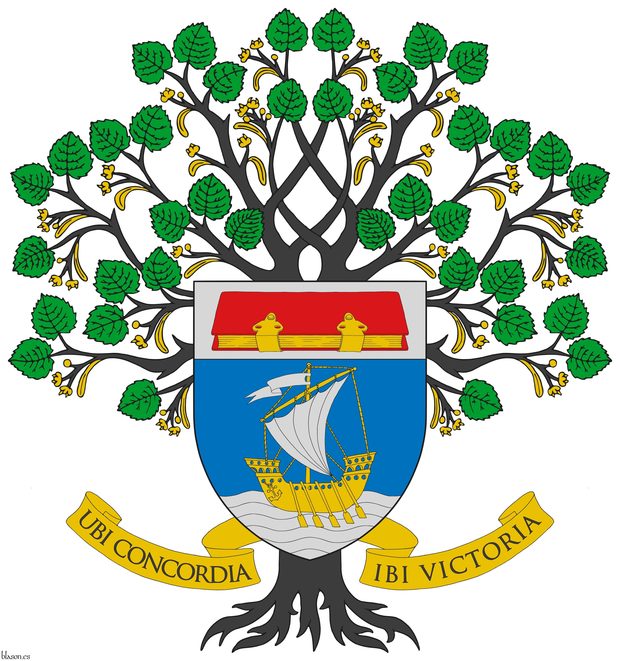
Azure, on waves of the sea in base Argent, a ship oars in action Or, pennant flying, and in full sail Argent; on a chief Argent, a closed book Gules, edges and clasps Or. Supporter behind the shield: A linden eradicated Sable, leaved Vert, fructed Or. Motto: «Ubi concordia ibi victoria» Sable over a scroll Or.
Escudo de azur, en punta un mar ondado de plata sumado de un barco con remos de oro, con vela y gallardete de plata; en un jefe de plata, un libro cerrado y brochado de oro, tapas de gules. Sostenido por un tilo arrancado de sable, hojado de sinople, frutado de oro acolado detrás del escudo. Lema: «Ubi concordia ibi victoria» de sable sobre una filacteria de oro.
Coat of arms devised by me, illuminated with lights and shadows, with a pointed outer contour and with a texturized finish.
The coat of arms of the Strategy Department of Consultoria.IO designed by Ignacio Perez de Bartolome and me and emblazoned by me. Consultoria.IO is a consulting firm specialized in scale-up e-commerce stores.
Design rationale
Teamwork navigating towards a common goal (lymphad with sail and oars), keeping trade secrets (book with clasps), and solidity in support and growth (linden). The motto «Ubi concordia ibi victoria» means «Where there is unity, there is victory». It conveys the idea that success arises from harmony and collaboration between the team and its clients, working together toward shared goals.
Blazon keywords: Azure, Argent, Or, Gules, Sable, Vert, One, Wavy, Sea, In base, On, Ship, Oar, Sail, Chief, Closed book, Book, Clasped, Supporter (thing), Supporter, Behind the shield, Linden, Eradicated, Leaved, Fructed, Motto and Scroll.
Style keywords: Illuminated, Pointed and Plain tincture.
Classification: Socioeconomic, Created, Boa, Coat of arms, Pennon and Flag.
Bearer: Strategy Department of Consultoria.IO.


B. Quesada, coat of arms with motto and support
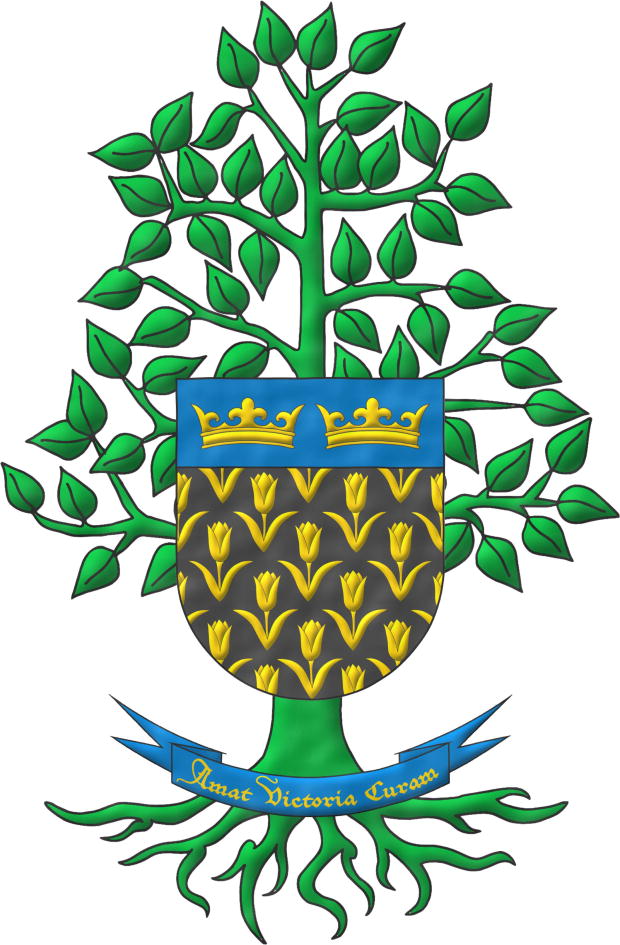
Sable, semé of Tulips Or; on a chief cousu Azure, two Crowns Or, in fess. Supporter A Tree Vert, eradicated. Motto «Amat victoria curam».
Escudo de sable, sembrado de tulipanes de oro; el jefe cosido de azur, dos coronas de oro, en faja. Por sostén un árbol de sinople, arrancado. Lema «Amat victoria curam» de oro, sobre una filacteria de azur.
The original design of this coat of arms, along with many others heraldic devices, is registered in [Salmerón Cabañas, A.; 2015a; page 11].
Blazon keywords: Without divisions, Sable, Or, Azure, Chief, Two, Crown, In fess, Semé, Tulip, Crest and mantling, Vert, Tree, Erased, Supporter (thing), Supporter, Motto and Scroll.
Style keywords: Watercolor, Semi-circular, Illuminated, Outlined in the field tincture, Outlined in sable and Cousu.
Classification: Coat of arms, Created and Personal.
Bearer: Quesada Valles, Bartolomé.


B. Quesada, video of the blazon
This video shows the ideation of this coat of arms step by step, its field, chief cousu, figures, motto and it supporter. The music is «Sonata No. 8 in G major – 1. Allegro» of Ludwig van Beethoven interpreted by Paul Rosenthal, violin, and Edward Auer, piano, available under an «Open Audio License».
Credits: Paul Rosenthal violin performance and Edward Auer piano performance.
Blazon keywords: Without divisions, Sable, Or, Azure, Chief, Two, Crown, In fess, Semé, Tulip, Vert, Tree, Erased, Supporter (thing), Supporter, Motto and Scroll.
Style keywords: Semi-circular, Illuminated, Outlined in the field tincture, Outlined in sable and Cousu.
Classification: Video, Created and Personal.
Bearer: Quesada Valles, Bartolomé.


![Ver [Castilian heraldry] en criterios utilizados. Unicornio saltante sobre la divisa, criterio.](../css/Unicornio.Criterio.png)
Castilian heraldry
Key Characteristics in Castilian Heraldry
Some of the main characteristics of the heraldry of Castile are:
- the rounded shapes, with a semicircle at the base,
- the importance of bordures,
- the inclusion of words and also letters in the coat of arms,
- the 2nd most common animal, after the lion, is the wolf [Valero de Bernabé, L.; 2010], and, of course,
- our castle triple-towered Or, port and windows Azure, masoned Sable [Valero de Bernabé, L.; 2009a].
The following image shows 4 examples of coats of arms, each of which has some of these characteristics, including one Castilian castle.
Comparing Castilian and English Heraldry
In the United Kingdom, there are several heraldic traditions, one of them being English heraldry.
In the Kingdom of Spain, there are several heraldic traditions, for example, the Castilian tradition.
In my humble opinion, we should compare at the same level, English heraldry with, for example, Castilian heraldry, but not with all Spanish heraldry. We shouldn't do it for the same reason we don't mix Scottish heraldic tradition with English, as they are so different.
In the case of Castilian heraldry, the 8 main differences with English heraldry are:
- The rounded shapes, with a semicircle at the base.
- The importance of bordures and the existence of the diminished bordure, called in Castilian «filiera».
- The inclusion of words and also letters in the coats of arms.
- The wolf is the 2nd most common animal, after the lion.
- The castle, triple-towered, which is different from the English and French types of castles.
- We can inherit arms from our mother and/or father; for example, the castle in the 1st quarter of the coat of arms of Castile and the coat of arms of Spain comes from a mother, Queen Berenguela of Castile, mother of King Fernando III, the Saint.
- There are 3 kinds of supporters with their owns heraldic names: «tenantes», human forms; «soportes», animals; and «sostenes», plants and things.
- Our quarterings do not necessarily mean that the arms are marshalled by inheritance. [Williams, N.; 2017; page 135, paragraph 26.02] describing the arms of Éamon de Valera, 1882-1975, President of Ireland, writes «Those arms are Spanish in appearance. The quartering without functions as a means of marshalling, is distinctively Iberian».
Categories: Criterion, Semi-circular, Bordure, Letter, Lion, Wolf, Castle, Triple-towered, Port and windows, Masoned, Or, Azure, Sable, Diminished bordure, Quarterly, Supporter (human form), Supporter, Supporter (animal) and Supporter (thing).


Columns of the Kingdom of Spain
Quarterly: 1 Gules, a castle triple-towered Or, port and windows Azure, masoned Sable [for Castile]; 2 Argent, a lion rampant Purpure, armed and langued Gules, crowned Or [for Leon]; 3 Or, four pallets Gules [for Aragon]; 4 Gules, a chain orlewise, crosswise, and saltirewise Or, charged in the fess point with an emerald Vert [for Navarre]; enté en point Argent, a pomegranate proper, seeded Gules, slipped and leaved Vert [for Granada]; an inescutcheon Azure, three fleurs de lis Or, 2 and 1, a bordure Gules [for Bourbon]. Crest: A closed royal crown. Supporters: two columns Argent, capital and base Or, between in base waves Azure, in chief an imperial crown the dexter and a closed royal crown the sinister. Moto environing the columns and behind the shield: «Plus Ultra» Or over a scroll Gules.
Coat of arms interpreted by me, highlighted with lights and shadows, contoured in Sable, with a semi-circular outer contour and with a iridescent finishing.
Arms of the Kingdom of Spain emblazoned by me. On the arrangement of the crowns: a) Royal Decree 1511/1977, of 21 January, enacted during the so-called Transition and approving the Regulations on Flags and Standards, Guidons, Insignia and Distinctive Signs, states: «Rule No. 2. Coat of Arms of Spain… Accompanied by two columns Argent, with base and capital Or, set upon waves Azure or blue and Argent», «superado» «by an imperial crown on the dexter one and by a royal crown on the sinister one…». b) The subsequent Law 33/1981, of 5 October, regulating the current coat of arms of Spain, likewise states: «…Accompanied by two columns Argent, with base and capital Or, set upon waves Azure or blue and Argent», «superado» «by an imperial crown on the dexter one and by a royal crown on the sinister one». c) The term «superado» in the heraldic dictionaries in which it appears refers, as a synonym, to «surmontado». d) The definitions of «surmontado» include: «a charge which, at its upper part, has another above it but without touching it», «also said of superado», and «a figure that bears another above it, but without touching it». In light of a), b), c) and d), the two crowns should therefore be painted not touching the columns. However, in the illustrative drawing contained in Royal Decree 1511/1977 the crowns do touch the columns, contradicting its own wording, although in heraldry, when in doubt, the written blazon always prevails; and in most official representations the crowns do indeed touch the columns. Nevertheless, this personal interpretation of both the coat of arms of Spain and of the proper way to write its blazon, where the lateral crowns do not touch the columns, and then I decide that, following the same criterion, the central crown should not touch the shield either, so the result differs from the official version. The expression «waves Azure or blue and Argent», which appears both in the 1977 official definition and in the 1981 one, presents a double peculiarity: it combines the heraldic term «Azure» with the everyday term «blue», and it is also offered as an optional blazon, giving two alternatives, that the waves be only Azure, as I have painted them, or Azure and Argent; optional blazons are extremely rare and, in my view, perhaps not very advisable.
Blazon keywords: Gules, Azure, Purpure, Vert, Or, Argent, One, Two, Three, Four, Quarterly, Castle, Triple-towered, Port and windows, Masoned, Lion, Rampant, Crowned, Pallet, Chain, Orlewise, Crosswise, Saltirewise, Charged, In the fess point, Emerald, Enté en point, Pomegranate, Proper, Slipped, Leaved, Inescutcheon, Fleur de lis, Ordered, Bordure, Closed royal crown, Crown, Supporter (thing), Supporter, Column, Shafted, Between, In base, Wave, In chief, Imperial crown, Dexter, Sinister, Motto, Environed, Behind the shield and Scroll.
Style keywords: Outlined in sable, Illuminated, Semi-circular and Iridescent.
Classification: Civic, Kingdom of Spain, Interpreted, Boa and Coat of arms.
Bearer: Spain, Kingdom of.


Kingdom of Spain, collage
Quarterly: 1 Gules, a castle triple-towered Or, port and windows Azure, masoned Sable; 2 Argent, a lion rampant Purpure, armed and langued Gules, crowned Or; 3 Or, four pallets Gules; 4 Gules, a chain orlewise, crosswise, and saltirewise Or, charged in the fess point with an emerald Vert; enté en point Argent, a pomegranate proper, seeded Gules, slipped and leaved Vert; an inescutcheon Azure, three fleurs de lis Or, 2 and 1, a bordure Gules. Crest: A closed royal crown. Supporters: two columns Argent, capital and base Or, between in base waves Azure, in chief an imperial crown the dexter and a closed royal crown the sinister. Moto environing the columns and behind the shield: «Plus Ultra» Or over a scroll Gules.
Arms of the Kingdom of Spain. This image combines three photographs of this coat of arms on the façade of the Ministry of Defence building on the Paseo de la Castellana in Madrid, just a few metres from my office, together with my own artistic interpretation of the same arms. In the version on the façade of the Ministry of Defence, the crowns above the columns do not touch the columns, which I believe is the correct way to depict them, although the central crown does appear to rest upon the shield of Spain. There are more interpretations that place the crowns resting on the columns than those that do not, and I photographed this particular version from the Ministry of Defence because it is especially relevant due to its size and institutional significance. On the arrangement of the crowns: a) Royal Decree 1511/1977, of 21 January, enacted during the so-called Transition and approving the Regulations on Flags and Standards, Guidons, Insignia and Distinctive Signs, states: «Rule No. 2. Coat of Arms of Spain… Accompanied by two columns Argent, with base and capital Or, set upon waves Azure or blue and Argent», «superado» «by an imperial crown on the dexter one and by a royal crown on the sinister one…». b) The subsequent Law 33/1981, of 5 October, regulating the current coat of arms of Spain, likewise states: «…Accompanied by two columns Argent, with base and capital Or, set upon waves Azure or blue and Argent», «superado» «by an imperial crown on the dexter one and by a royal crown on the sinister one». c) The term «superado» in the heraldic dictionaries in which it appears refers, as a synonym, to «surmontado». d) The definitions of «surmontado» include: «a charge which, at its upper part, has another above it but without touching it», «also said of superado», and «a figure that bears another above it, but without touching it». In light of a), b), c) and d), the two crowns should therefore be painted not touching the columns. However, in the illustrative drawing contained in Royal Decree 1511/1977 the crowns do touch the columns, contradicting its own wording, although in heraldry, when in doubt, the written blazon always prevails; and in most official representations the crowns do indeed touch the columns. Nevertheless, this personal interpretation of both the coat of arms of Spain and of the proper way to write its blazon, where the lateral crowns do not touch the columns, and then I decide that, following the same criterion, the central crown should not touch the shield either, so the result differs from the official version.
Blazon keywords: Gules, Azure, Purpure, Vert, Or, Argent, One, Two, Three, Four, Quarterly, Castle, Triple-towered, Port and windows, Masoned, Lion, Rampant, Crowned, Pallet, Chain, Orlewise, Crosswise, Saltirewise, Charged, In the fess point, Emerald, Enté en point, Pomegranate, Proper, Slipped, Leaved, Inescutcheon, Fleur de lis, Ordered, Bordure, Closed royal crown, Crown, Supporter (thing), Supporter, Column, Shafted, Between, In base, Wave, In chief, Imperial crown, Dexter, Sinister, Motto, Environed, Behind the shield and Scroll.
Style keywords: Outlined in sable, Illuminated and Semi-circular.
Classification: Civic, Kingdom of Spain, Interpreted, Boa, Photographic and Collage.
Bearer: Spain, Kingdom of.
-
Language
-
Categories of heraldry
-
Divisions of the field
- Without divisions
- Party per pale
- Party per fess
- Party per bend
- Party per bend sinister
- Tierce
- Tierce sinister
- Tierced per pale
- Tierced per fess
- Tierced per bend
- Tierced pallwise inverted
- Quarterly
- Quarterly per saltire
- Gyronny
- Party per fess, the chief per pale
- Party per pale, the sinister per fess
- Party per fess, the base per pale
- Party per pale, the dexter per fess
- Chapé
- Chaussé
- Embrassé
- Contre-embrassé
- Party per chevron
- Enté
- Enté en point
- Flanched
-
Metals
-
Colours
-
Furs
-
Other tinctures
-
Ordinaries and sub-ordinaries
-
Diminutives of the ordinaries
-
Geometric charges
-
Composite ordinaries
-
Inanimate charges from Nature
Atom, Crescent, Diamond, Emerald, Estoile, Increscent, Lightning flash, Moon, Mount, Mullet, Mullet of four points, Orbital, Plough of Ursa Major, Rainbow, Ray of the sun, River, Sea, Snowflake, Sun, Sun in splendour, Sun of May, Trimount, Water and Wave.
-
Vegetal charges from Nature
Acorn, Apple, Apple tree, Ash, Bluebonnet, Camellia, Chrysanthemum, Cinquefoil, Cornflower, Dogwood flower, Double rose, Elm, Fleur de lis, Flower, Gourd, Holm oak, Hop cone, Kapok tree, Laurel, Lily, Linden, Lotus flower, Madonna lily, Mexican cedar tree, Oak, Olive tree, Palm tree, Plantain plant, Pomegranate, Poplar leaf, Rose, Shamrock, Sunflower, Thistle, Tree, Tulip, Vine and Wheat.
-
Animal charges from Nature
Badger, Bald eagle, Barbel, Barn owl, Bear, Beaver, Beetle, Bighorn sheep, Blackbird, Boar, Brach hound, Bull, Doe, Dog, Dolphin, Dove, Eagle, Elephant, Falcon, Female figure, Fish, Flame, Fly, Fox, Frog, Goat, Goldfinch, Goose, Heron, Horse, Hummingbird, Jaguar, Lark, Leopard, Lion, Lion passant, Lion rampant guardant, Lioness, Lynx, Male figure, Martlet, Merino ram, Owl, Panther, Parrot, Peacock, Pelican, Pelican in her piety, Puffin, Quetzal, Raven, Roe deer, Rooster, Savage, Seagull, Serpent, She-wolf, Stag, Starling, Talbot, Tyger, Vulture, Warren hound and Wolf.
-
Parts of natural charges
Arm, Beak, Branch, Caboshed, Chest, Claw, Covert, Dorsal fin, Eagle claw, Ermine spot, Escallop, Feather, Foot (palmiped), Foreleg, Forepaw, Hand, Head, Heart, Hoof, Leaf, Neck, Ostrich feather, Palm frond, Paw, Roe deers' attires, Shoulder, Sprig, Stags' attires, Stem, Swallow-tail, Tail, Tail addorsed, Tail fin, Talon, Tooth, Trunk, Trunk (elephant), Two hands clasped, Two wings in vol, Udder, Wheat spike, Wing and Wrist.
-
Artificial charges
Ace of spades, Anchor, Anvil, Arch, Arm vambraced, Armillary sphere, Arrow, Axe, Bell, Bell tower, Beret, Bonfire, Book, Bookmark, Bow, Branding iron, Bridge, Broken, Buckle, Cannon, Cannon dismounted, Cannon port, Canopy roof, Carbuncle, Castle, Celtic Trinity knot, Chain, Chess rooks, Church, Clarion, Clay pot, Closed book, Club, Column, Comb, Compass rose, Conductor's baton, Cord, Covered cup, Crozier, Crucible, Cuffed, Cup, Cyclamor, Dagger, Double vajra, Drum, Ecclesiastical cap, Fanon, Federschwert, Fleam, Four crescents joined millsailwise, Galician granary, Garb, Gauntlet, Geometric solid, Grenade, Halberd, Hammer, Harp, Host, Hourglass, Key, Key ward, Knight, Knot, Lantern, Letter, Line, Loincloth, Menorah, Millrind, Millstone, Millwheel, Monstrance, Mortar, Mullet of six points pierced, Nail, Non-classic artifact, Norman ship, Number, Oar, Oil lamp, Open book, Page, Pair of scales, Parchment, Pestle, Piano, Pilgrim's staff, Plough share, Polish winged hussar, Port, Portcullis, Potent, Quill, Ribbon, Rosette of acanthus leaves, Sabre, Sackbut, Sail, Scroll, Scythe, Sheaf of tobacco, Ship, Skirt, Spear, Spear's head, Stairway, Star of David, Step, Sword, Symbol, Tetrahedron, Torch, Tower, Trident, Trumpet, Turret, Two-handed sword, Wagon-wheel, Water-bouget, Wheel, Winnowing fan and With a turret.
-
Immaterial charges
Angel, Archangel, Basilisk, Dragon, Dragon's head, Garuda, Golden fleece, Griffin, Heart enflamed, Justice, Mermaid, Our Lady of Mercy, Ouroboros, Paschal lamb, Pegasus, Phoenix, Sacred Heart of Jesus, Saint George, Sea-griffin, Trinity, Triton, Unicorn, Winged hand and Wyvern.
-
External elements
-
Heraldic creations
-
References
-
Formats
-
Keywords on this page
Port and windows, Behind the shield, Between, Proper, Pointed, Erased, Eradicated, Azure, Flag, Ship, Boa, Bordure, Clasped, Chain, Charged, Castle, Environed, Column, Crown, Imperial crown, Closed royal crown, Crowned, Cousu, Created, Quarterly, Four, Triple-towered, Outlined in sable, Outlined in the field tincture, Dexter, Two, In base, Coat of arms, Scroll, Gules, Leaved, Illuminated, Chief, Motto, Lion, Masoned, Semi-circular, Or, Argent, Sable, Vert, Supporter, Supporter (thing) and One.


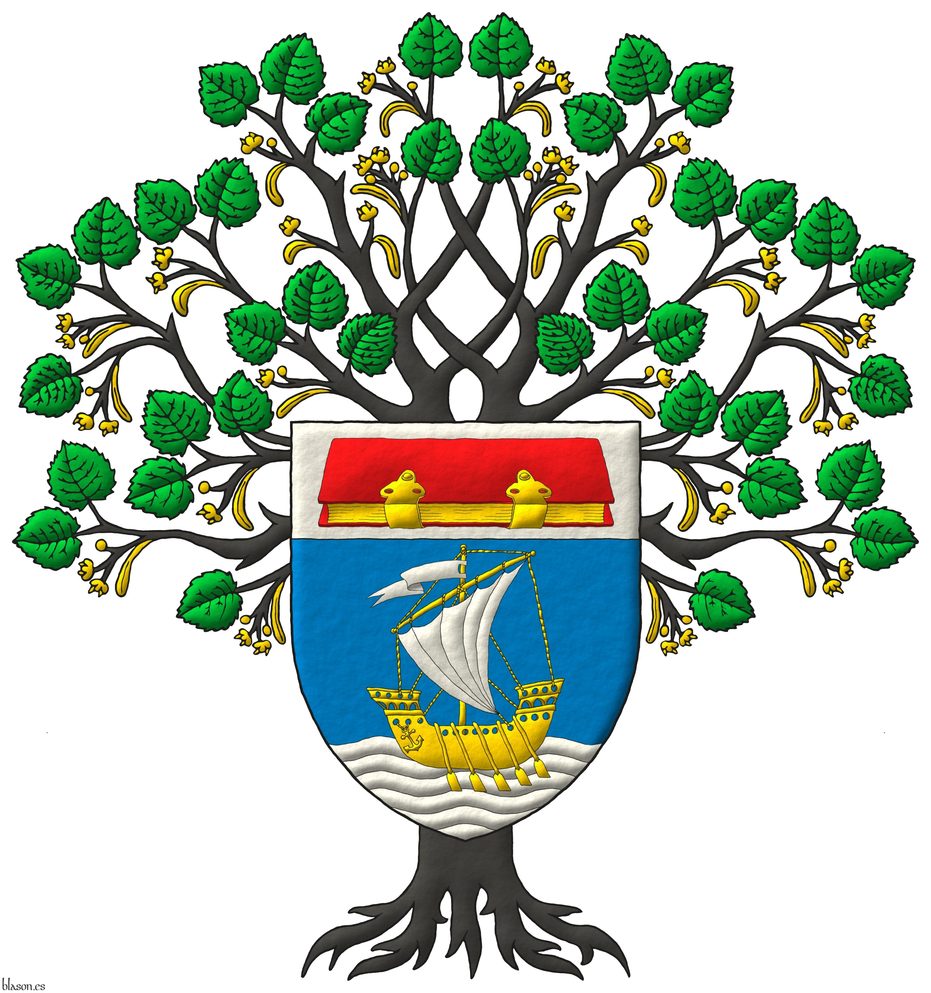
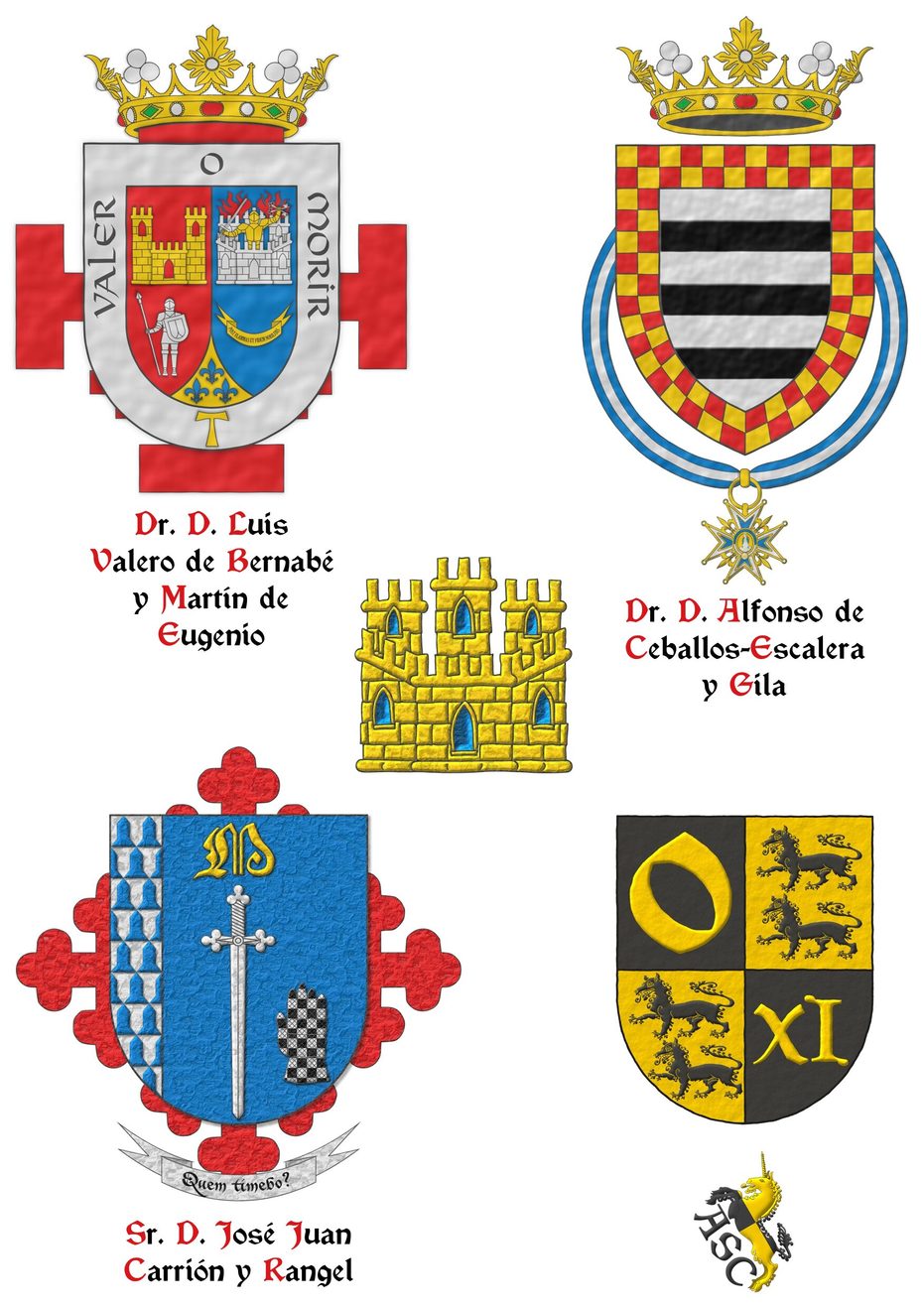
![Columns of the Kingdom of Spain Quarterly: 1 Gules, a castle triple-towered Or, port and windows Azure, masoned Sable [for Castile]; 2 Argent, a lion rampant Purpure, armed and langued Gules, crowned Or [for Leon]; 3 Or, four pallets Gules [for Aragon]; 4 Gules, a chain orlewise, crosswise, and saltirewise Or, charged in the fess point with an emerald Vert [for Navarre]; enté en point Argent, a pomegranate proper, seeded Gules, slipped and leaved Vert [for Granada]; an inescutcheon Azure, three fleurs de lis Or, 2 and 1, a bordure Gules [for Bourbon]. Crest: A closed royal crown. Supporters: two columns Argent, capital and base Or, between in base waves Azure, in chief an imperial crown the dexter and a closed royal crown the sinister. Moto environing the columns and behind the shield: «Plus Ultra» Or over a scroll Gules.](../escudo_armas/EspanaR.25.Soportes.Irisado.Avr20.jpg)
